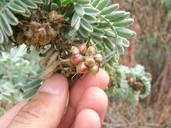Taxon Details
Astragalus pycnostachyus var. lanosissimus
Ventura Marsh milk-vetch
View Report Copy Link Calflora eFlora CCH CalPhotos iNaturalist
Taxon Summary:
Astragalus pycnostachyus var. lanosissimus, commonly known as Ventura Marsh milk-vetch, is a perennial herb in the Fabaceae that is found only in California. It occurs within Coastal dunes, Coastal scrub, Marshes and swamps (edges, coastal salt, and brackish), growing at elevations from 1 to 35 meters. Astragalus pycnostachyus var. lanosissimus is ranked 1B.1, Plants Rare, Threatened or Endangered in California and Elsewhere; Seriously threatened in California.|
Scientific Name: Astragalus pycnostachyus Gray var. lanosissimus (Rydb.) Munz & McBurn. |
||
|
Common Name: Ventura Marsh milk-vetch |
||
| Family: | Fabaceae | |
| Element Code: | PDFAB0F7B1 | |
| USDA Plants Symbol: | ASPYL | |
|
Synonyms/Other Names: |
||
| Name Status: |
JEF, FNA, POWO, IPNI, Tropicos |
|
| CA Rare Plant Rank: | 1B.1 |
| Fed List: | FE (2001-05-21) |
| State List: | CE (2000-04-01) |
| Global Rank: | G2T1 |
|
State Rank: |
S1 |
| Other Status: | SB_CalBG/RSABG; SB_SBBG |
|
CRPR Changes: |
|
| Add Date: | 1974-01-01 |
| Date Edited: | 2025-10-29 |
| Lifeform: perennial herb | ||||||||||||||
Blooming Period: (Jun)Aug-Oct
|
||||||||||||||
|
Elevation:
1 - 35 meters 5 - 115 feet |
||||||||||||||
General Habitats:
|
||||||||||||||
| Microhabitat Details: | ||||||||||||||
|
Microhabitat:
|
||||||||||||||
|
Notes: Rediscovered near Oxnard in 1997. Experimental reintroductions underway as of 2003. |
|
|
Threats: Threatened by development, herbivory, cucumber mosaic virus, non-native plants, and hydrological alterations. |
|
|
Taxonomy: See North American Flora 24:357-358 (1929) for original description, and Memoirs of the New York Botanical Garden 13:813 (1964) for taxonomic treatment. |
|
| Threat List Total: | 6 | |
| Total EOs | % of EOs | |
| EOs with Threat Listed: | 1 | 14 % |
| THREAT LIST: | ||
|---|---|---|
| Development | 1 | 14% |
| Foot traffic/trampling | 1 | 14% |
| Non-native plant impacts | 1 | 14% |
| Other | 1 | 14% |
| Over-collecting/poaching | 1 | 14% |
| Pollution | 1 | 14% |
| Total Occurrences: | 7 | ||||
| Element Occurrence Ranks: | |||||
|---|---|---|---|---|---|
| A | B | C | D | X | U |
| 0 | 0 | 0 | 1 | 6 | 0 |
| Occurrence Status: | |||||
|---|---|---|---|---|---|
| Historical >20 Years | 6 | ||||
| Recent <=20 Years | 1 | ||||
| Presence: | |||||
|---|---|---|---|---|---|
| Presumed Extant | 1 | ||||
| Possibly Extirpated | 3 | ||||
| Presumed Extirpated | 3 | ||||
| California Endemic: | |||||||||||||
| California Island: | |||||||||||||
|
States: Name (Code) California (CA) |
|||||||||||||
|
California Counties and Islands: Name (Code) Los Angeles (LAX)*, Orange (ORA)*, Ventura (VEN) |
|||||||||||||
|
Quads: Name (Quad Code) Beverly Hills (3411814), Oxnard (3411922), Pitas Point (3411934), Saticoy (3411932), Seal Beach (3311861)*, Topanga (3411815)*, Venice (3311884)*, Ventura (3411933)* |
|||||||||||||
Notes:
|
|||||||||||||
 Presumed Extant
Presumed Extant
Click on quad for name. Hold Shift Key to use mouse scroll wheel



